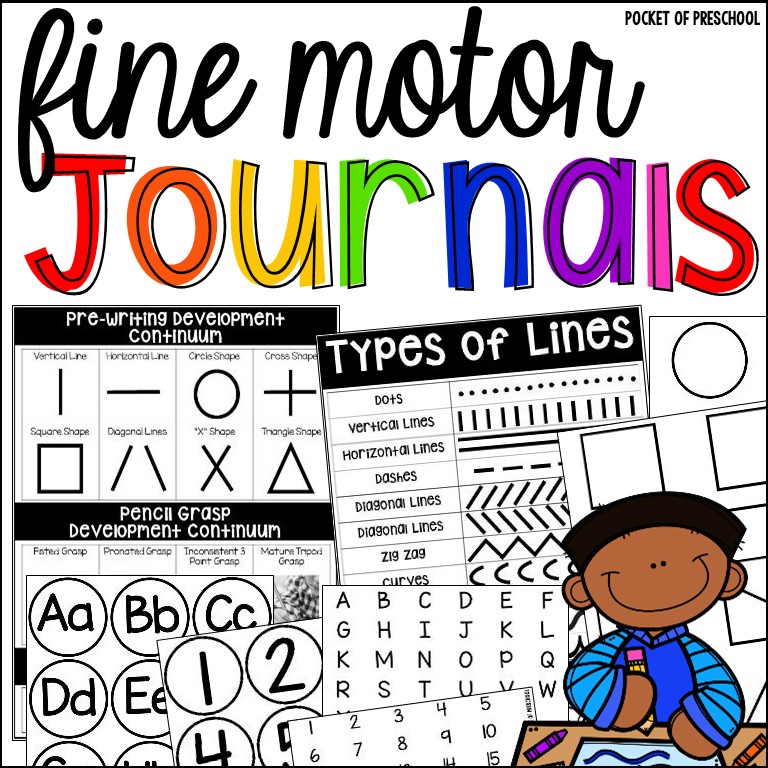
Fine Motor Journals are a place where students can do various fine motor activities such as writing, drawing, name activities, and cutting! It’s like a mini-portfolio just about a student’s fine motor skills, so instead of tons of random papers with fine motor activities, it’s now in one organized spot! Fine motor journals are FUN short activities to support students learning how to write, draw, cut, and develop strong fine motor skills and match the learning theme (ex: transportation, pets, Valentine’s Day, Earth Day, fall, spring) you are doing in your classroom.
The focus and main objective of fine motor journals is to strengthen, increase, and develop fine motor strength and dexterity in a fun, hands-on way. Keep reading because I’m going to share the benefits of fine motor journals, how to implement them, organization ideas, and tons of ideas for activities you can do in fine motor journals!
>>Want my GIANT printable Fine Motor Journals Unit Guide with over OVER 380 ideas of fine motor journal ideas with photographs, developmental continuums, teacher instruction pages, and more? Grab it HERE in my TpT store. <<
What students are learning?
The focus or main objective of Fine Motor Journals is just that: to strengthen, increase, and develop fine motor strength and dexterity in a fun, hands-on way.
Fine motor skills students will develop during Fine Motor Journals are:
- Overall hand, wrist, and finger strength
- Pencil grasp
- Scissor skills
- Hand dominance
- Muscle memory
- Visual perception: the ability to interpret and make sense of what we see
- Bilateral integration: using both hands or sides of the body to do a coordinated task (ex: one hand holds the paper and the other hand draws with a crayon)
- Hand-eye coordination: use the eyes to visually guide movement for a task (ex: catching a ball, lace beads)
- Visual-motor integration: ability to visually see information, process it, and move your hands appropriately (tracing a circle zig-zag, copying a circle shape)
- Handwriting foundations/pre-writing skills: tracing and copying various types of lines, shapes, letters, and numbers
Students can develop other skills based on the fine motor journal activity such as letter recognition, letter sounds, concepts of print, vocabulary, counting, number recognition, shape recognition, and more. But remember the FOCUS for fine motor journals is on developing fine motor strength and dexterity.
It is critical for students to develop fine motor and pre-writing skills in order to be able to write letters, hold a writing tool, and become successful writers and illustrators.
Letters and numbers are made up of l, -, /, \, (, ), +, X, o types of lines. Students need to be able to make various types of lines BEFORE they can make letters. Here are a few developmental pre-writing and fine motor continuums to help you plan and execute developmentally appropriate activities during fine motor journal time.

Included is a parent/family letter to send home and post in the classroom so families know what students are learning. Share this quick handout and developmental continuum with staff and subs and use it during planning to ensure developmentally appropriate expectations and activities are planned and taught.

Types of Fine Motor Journal Activities
There are so many fine motor activities you can do in a journal! Here are some of my favorite:
- Writing types of lines/letters
- Name activities
- Letter activities
- Number activities
- Stamp activities
- Torn paper collages
- Cutting collages
- Sticker activities
- Drawing activities
- Hole punch activities
- Tape activities
Supplies – Check out my Fine Motor Supply List on Amazon HERE.
Journals: Each student will need their own journal. Store-bought spiral notebooks are the best to use. Going back, I would not use composition notebooks because the front cover doesn’t stay flat.
Name Cards and Pockets: Create name cards for each student for a visual support to help write their name. I make my name cards double-sided. One side has their name in all capital letters and the other side has their name in lowercase. I glue them back to back, laminate, and cut them out. Tape a pocket to the inside cover of each students’ journal. Place the name cards in the pocket for students to use as needed.

Other Supplies: (if it states included, it is a printable is included in the Fine Motor Journals Unit Guide)
Check out my Fine Motor Supply List on Amazon HERE.
- Stickers (dots, themed, seasonal, holiday, letters, shapes, numbers)
- Scissors and glue sticks (loop scissors too)
- Paper shapes to cut (printable included)
- Collage materials (flat so the journal will close) (letters, numbers that are included)
- Stamps (letters, numbers, shapes, animals, etc.)
- Paper punches
- Tape (masking tape, colored tape, washi tape)
- Types of lines cards (included)
- Letter and number cards (included)
- Letter, number, and shape manipulatives
- Name cards (included)
Organization: Get organized so you save instruction time!
Here are quick tips to help keep everything organized!
- Writing Tools: place in caddies or buckets
- Journals: store in a folder, magazine file, tub, crate, or basket
- Letter and Number Cards: Keep baggies in the basket
- Types of Lines Cards: Keep the Types of Lines and Shapes handouts and cards on a book ring in the basket
- Developmental Continuum: Place the developmental continuum in the basket
- Paper Shapes and Lines: Print on colored paper and place in baskets so you can easily grab them for an activity
- Collage Paper Letters and Numbers: Print on colored paper and place in plastic tubs so you can easily grab them for an activity
- Trash Buckets: if there will be trash, place small buckets or tubs for students to put it in.
- Teacher Resource Binder: Bind or place the Fine Motor Journal Unit Guide in a binder for you to use during planning! There are over 350 ideas included by theme, letter, and activity type.

Starting Fine Motor Journals
Make it a Routine: Just like any other part of your day make, journal time consistent and a predictable routine or procedure so students know what to expect and what is expected of them. Send home the family letter with the developmental continuum (with or without ages).
Fine Motor Journal Routine:
- Sit at the table
- Get your journal
- Open it to the next page (this can take a lot of practice or you can use binder clips to help them easily flip to the next page)
First Week: Starting fine motor journals will take practice and modeling just like any classroom routine or procedure. Do very simple things the first week and get them excited about Fine Motor Journals. If you are excited, they will be excited.
Ideas for the first week:
- Day 1: Free draw/scribble
- Day 2: Sticker collage
- Day 3: Make dots
- Day 4: Glue small collage shapes/items (to practice using a glue stick)
- Day 5: self-portrait (free draw on the opposite page or around their drawing if they finish quickly)
Extra Supports and Early Finishers
Some students may need extra support so they can be successful and work at an easier level. Some of these supports I used with my entire class like tearing strips of paper for tearing paper activities. Tearing paper is HARD so I would tear paper strips for tearing paper activities for my whole class.
TEACH Types of Lines FIRST before teaching students how to write tricky letters. Teach students how to make various types of lines FIRST. If you teach preschool or if your students have weaker fine motor muscles, you may need to spend months just teaching students how to make various types of lines! That is OK because that is what they need to grow and be successful writers and illustrators later.
Students need direct instruction on how to form various types of lines and letters through modeling and thinking aloud while writing (describing how to make the line or letter). We want students to develop the correct motor memory for writing lines and letters.
Only focus how to make one new or challenging type of line at a per lesson. Again, making various types of lines is HARD. Start with the easiest lines (straight line down) and shapes (circle) then teach the harder types of lines (zig zags, bumps) and shapes (triangle). See the pre-writing developmental continuums to see what age various pre-writing skills typically occur.
Connect it to a Letter or Number: Notice and talk about what types of lines and shapes letters and numbers are made of. After making the type of lines, WRITE a letter or number that has this type of lines on the opposite page or on the back! It is so important to HELP students make those CONNECTIONS!
Use Objects & Props for Visuals: Show the object or prop of what you are drawing or writing to help students visualize what they are going to draw. This will also build students’ vocabulary and background knowledge. Notice and talk about the shapes and type of lines on the object. Not all students may have background knowledge about what you are drawing or may not have seen it in their real life. Using a prop builds background knowledge so the student can be more successful!
What you can use for a prop: Real object (that’s the best option but not always possible), plastic figures, plastic food, felt food, felt objects, photographs (Goggle images is a great place to look and it’s free), photographs from a book, vocabulary cards, or show an image on the SMART board or other device
Ideas for Each Day
There are endless activities you can do in a fine motor journal to develop fine motor skills! You can plan fine motor journal activities based on skills or standards or the learning theme. It can be exhausting planning everything every day, so included are over 400 different fine motor journal ideas (with a photograph for each one) help you plan and create amazing fine motor journal activities. Print these idea pages and place them in your lesson plan binder or a folder to make planning easier for you! They are organized by theme, letter, and type of activity (cutting shapes, stickers, paper collage letters, etc.).
Here are some ideas of things you can do in fine motor journals!
- Writing/drawing types of lines, then making a letter on the next page
- Drawing Fine Motor ideas
- Names
- Stickers
- Stamps
- Paper Punches
- Scissor Skills
- Ideas by Theme (seasons, holidays, and favorite themes)
Check out all the fine motor ideas included to help make planning less work for you! Teaching is hard so let me help!
Now that you are ready to start Fine Motor Journals grab the unit HERE in my TpT Store or here in my Pocket of Preschool Store! There are many teacher resource pages and printables to help you set up, implement, and organize Fine Motor Journals in your classroom. Trust me, once you start fine motor journals in your classroom, you won’t want to stop when you see how students grow from implementing them!

Want to see fine motor journals in action? Check out the video!
Love it? Pin this image!

hey, i’m jackie!
I’m Jackie, your go-to girl for early childhood inspiration and research-based curriculum.
























